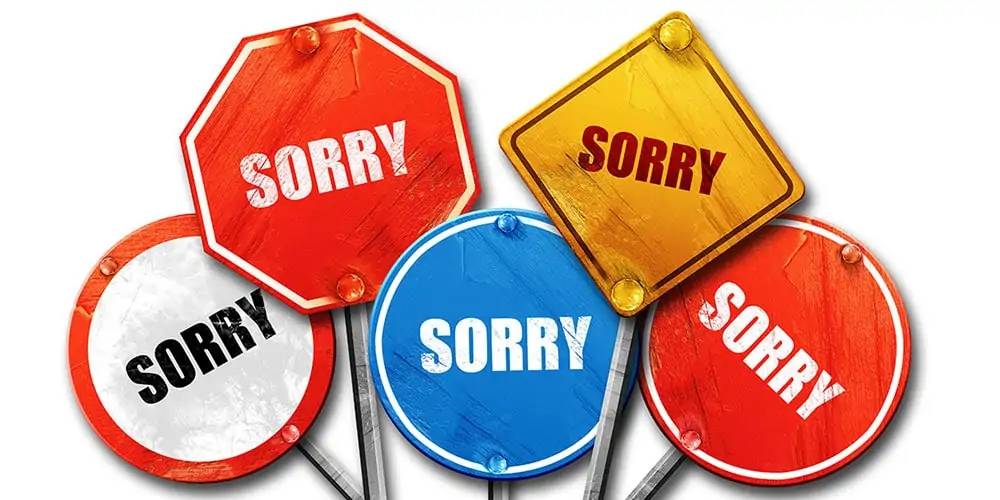In today’s hyper-connected world, mistakes and missteps can quickly spiral into public relations disasters. Whether you’re a CEO facing a corporate scandal, a public figure caught in controversy, or a business owner dealing with customer complaints, knowing how to craft an effective public apology is essential for damage control and reputation recovery.
Research shows that effective apologies contain specific elements that make them more likely to be accepted and forgiven. When done correctly, a public apology can strengthen relationships, demonstrate leadership qualities, and showcase your commitment to doing better. However, poorly executed apologies have become notorious for making situations worse, sometimes landing leaders on “worst communicators” lists and causing irreparable damage to their credibility.
The stakes are high, but the formula for success is clear. A well-crafted public apology goes beyond simply saying “I’m sorry” – it requires strategic thinking, emotional intelligence, and a deep understanding of your audience’s needs and expectations. By following proven frameworks and incorporating key psychological elements, you can transform a crisis into an opportunity to demonstrate integrity, accountability, and genuine remorse.
Understanding the Psychology Behind Effective Apologies

Effective apologies work because they address fundamental human psychological needs. When someone has been wronged, they typically seek validation of their feelings, acknowledgment of the harm caused, and assurance that the offense won’t happen again. A successful public apology taps into these emotional needs while also addressing practical concerns about accountability and future prevention.
The most critical psychological element is the acknowledgment of responsibility. Research indicates that taking full ownership of mistakes is the most important component of an effective apology. This means avoiding passive language like “mistakes were made” and instead using direct statements such as “I made a mistake.” This approach demonstrates integrity and builds trust by showing that you’re willing to be vulnerable and accountable.
The Six Essential Elements of a Powerful Public Apology
Scientific research has identified six key components that make apologies more effective, with studies showing that including more elements increases the likelihood of acceptance:
Expression of Regret forms the foundation of any apology. This goes beyond a simple “I’m sorry” to include genuine emotional expression that conveys your understanding of the impact your actions had on others. The key is matching your tone and body language to your words to ensure authenticity.
Explanation of What Went Wrong provides context without making excuses. This element helps the audience understand whether the offense was intentional or accidental, but it must be delivered carefully to avoid sounding defensive. Keep explanations brief and focused on facts rather than justifications.
Acknowledgment of Responsibility represents the most crucial element according to research. This means explicitly stating your role in the situation and avoiding language that shifts blame or minimizes your accountability. Use phrases like “I was responsible for” rather than vague statements that obscure ownership.
A Declaration of Repentance demonstrates your commitment to personal growth and change. This element shows that you understand the moral implications of your actions and are committed to becoming better. It’s about expressing genuine remorse for the harm caused, not just regret about getting caught.
Offer of Repair addresses the practical question of “what happens next?” This component should outline specific steps you’ll take to fix the immediate problem and prevent similar issues in the future. Concrete actions carry more weight than vague promises of improvement.
Request for Forgiveness acknowledges that forgiveness must be earned rather than demanded. This element should be proportionate to the offense and delivered with humility, recognizing that the injured party has every right to withhold forgiveness until trust is rebuilt.
Timing and Delivery: Getting the Mechanics Right

The timing of your public apology can make or break its effectiveness. Immediate response demonstrates that you take the situation seriously and respect those who have been affected. However, rushing to apologize without understanding the full scope of the problem can backfire if new information emerges that contradicts your initial statement.
The ideal approach is to issue a preliminary acknowledgment quickly, followed by a comprehensive apology once you have all the facts. This shows both responsiveness and thoroughness. Consider the delivery method carefully – controlling the narrative through your own channels (website, social media, press conference) is generally more effective than relying on third-party media.
Your physical presentation matters as much as your words. Maintain strong eye contact, use varied vocal tones to avoid sounding robotic, and ensure your body language matches your message. Even slight inconsistencies between what you say and how you appear can undermine your credibility.
Language and Tone: Crafting Your Message
The language you use in your public apology should be straightforward and conversational rather than formal or scripted. Complex jargon or corporate-speak can create distance between you and your audience, making your apology seem insincere or calculated. Simple, concrete words and short sentences are more effective for conveying genuine remorse.
Avoid conditional language that suggests your regret depends on others’ reactions. Phrases like “I’m sorry if you were offended” or “I apologize if anyone was hurt” minimize the legitimacy of others’ feelings and shift responsibility back to them. Instead, use direct statements like “I’m sorry for the pain I caused” or “I apologize for my insensitive comments.”
The tone should balance humility with strength. While you need to show genuine remorse and vulnerability, you also want to demonstrate that you’re capable of learning from the experience and moving forward constructively. This balance helps maintain confidence in your leadership abilities while acknowledging your human fallibility.
Avoiding Common Pitfalls That Undermine Apologies

Many public apologies fail because they include elements that actually make the situation worse. One of the most common mistakes is making excuses or providing lengthy explanations that sound defensive. While context can be helpful, explanations should be brief and focused on clarification rather than justification.
Another frequent error is failing to acknowledge the specific harm caused. Vague apologies that don’t address the particular impact of your actions can seem dismissive of others’ experiences. Be specific about what you did wrong and how it affected others, showing that you truly understand the consequences of your behavior.
Self-punishment or excessive self-flagellation can also backfire by making the apology about your guilt rather than the harm you caused. The focus should remain on those who were affected and what you’ll do to make things right, not on relieving your own emotional burden.
Making Amends: Following Through on Your Commitments
A public apology is only as good as the actions that follow it. The “offer of repair” component must be backed up with concrete steps that address both immediate damage and long-term prevention. This might involve financial compensation, policy changes, additional training, or other specific measures relevant to your situation.
When determining how to make amends, consider asking affected parties what would be most meaningful to them rather than assuming you know what they need. This approach shows respect for their perspective and increases the likelihood that your efforts will be well-received.
Follow-up communication is crucial for demonstrating your commitment to change. Regular updates on the progress you’re making toward your stated goals help rebuild trust and show that your apology was more than just words.
Measuring Success and Learning from the Experience
The effectiveness of your public apology can be measured through various indicators: media coverage tone, social media sentiment, stakeholder feedback, and long-term relationship outcomes. Pay attention to these signals and be prepared to adjust your approach if initial reactions suggest your message isn’t landing as intended.
Use the experience as a learning opportunity to strengthen your crisis communication capabilities and prevent similar situations in the future. Document what worked well and what could be improved for future reference, and consider incorporating these lessons into your organization’s crisis management protocols.

